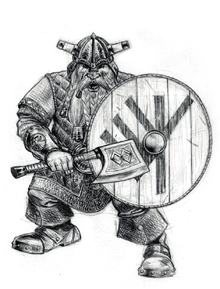You don’t play the battlepipes, the pipes play you."
The Dwarven Holds, historically known as the Western Dwarves, are a playable faction in the game The 9th Age: Fantasy Battle. The faction consists of numerous independent cities, known as Holds, united by a shared species and culture. The Holds are fortified mines that house the dwarven communities.
Dwarven Holds are found primarily in Vetia, though they do exist in other parts of the world too.
Geography[]
The Dwarven Holds control great mines all around the world.[2] They have an especially strong presence in Vetia, with many lucrative mines.[3] There they also control the White Mountains.[4]
Holds[]
The dwarven word "Nevaz", meaning "hold" or "holdfast", refers to their fortified communities.[5] These are underground fortress-mines, often escalated long ago[6].
There are four major holds known today:[7]
- Nevaz Vanez
- Nevaz Barim
- Nevaz Derom
- Kegiz Gavem
There are other holds too around the world, including:
History[]

From the Second Age tapestry of the World Hymn. Corresponds with the line from the poem: "That golden time as West met East".
The Dwarven Holds trace their history back to the great Dwarven Empire of the Second Age[9], when the Western and Eastern Dwarves were united[10].
Over the course of the Ages of Ruin, the Western Dwarves of the empire started taking refuge in the great mines of their cites. These had been escalated long before, but now provided increased protection from the calamities outside. [6]
In the Fourth Age, the empire was split apart as the Eastern Dwarves were cut off by large amounts of foes. [11] However, there are also claims of betrayal by both sides.[12]

From the Fourth Age tapestry of the World Hymn. Corresponds with the line from the poem: "Endless foes did split us sunder".
The migration of the Western Dwarves into their mines was accelerated in the Eighth Age. As stone provides a natural protection against magic[13], the underground realm made for excellent protection against the daemons that welled forth after the creation of the Inferno and the Wasteland. [6]
At the start of the Ninth Age, the surviving holds held a great moot, establishing the loose coalition since known as the Dwarven Holds.[6] At this moot, known as the First Moot, which lasted for weeks if not months, the empire of old was declared a thing of the past. Instead, each hold would have to survive on its own. However, strong connections were maintained between many holds, through oaths and promises, many of which still endure. [5]
Culture[]
Despite being separated geographically, the many holds of the dwarves have a shared culture[6]. Through common cooperation and interaction between holds, this has been maintained. Marriges between holds is very common, and the guilds of one hold usually recognize members from sister guilds in other holds. [5]

A dwarf.
In part, the culture is maintained through the formal education system of the Dwarven Holds. Overseen by the Guild of Lorekeepers, all dwarves have to undergo this education before they can be considered full adults. There they learn matters of honour and law, among other things. Supposedly, honour is an all-consuming affair to a dwarf, which governs every aspect of their lives. [6]
The language of the Dwarven Hold, known as Adroz[14], too has remained shared between holds. Though it has been influenced by neighbouring languages such as Avrasi and Sonnsprache, dwarves from any hold in the world can supposedly make themselves understood. [5]
The society of the Dwarven Holds is said to be merit based and highly equalitarian. Handed down wealth is all but unknown, it is even said that Adroz lack a word for "inheritance", instead parent and child work toward common goals. This has also lead to equality between sexes. Female and male dwarves can be found on all levels of society. [15]
Religion[]
The religion of the Dwarven Holds has been described as a non-theistic form of spiritualist cosmology. It involves ritualistic meditation focused on permanence and the holy depths. The exception is the cult of the Seekers. These still worship the same gods that were worshipped in the empire of the Golden Age. [6]
Worship of the Dark Gods is not unknown among dwarves. In the Dwarven Holds, such worship is not tolerated. The Deep Watch are tasked with rooting out those that do. [16]
Magic use[]

A runic anvil.
Out of necessity, the dwarves of the Dwarven Holds do not use magic in the common way. The high concentration of wolfram in their structures, combined with the fact that they live underground where magic has a hard time to penetrate, make magic use tricky. Instead they use runes, sometimes called Battle Runes. These are physical objects, forged from wolfram and carved with runic writing. They siphon magic from their surrounding, effectively making spellcaster more difficult in their vicinity. After a long time, this magic can be released at the user's command, to create an instantaneous and pre-determined effect. [13][15]
Supposedly however, there are dwarves in the holds that do dabble in traditional magic. Sometimes, these few are even said to migrate to the Infernal Dwarves, where they can practise this craft much more freely. [15]
Government[]
Supposedly, most holds operate a gerontocracy.[14] The ruler of each hold has a title that is best translated as king. This title makes no difference between the sexes, and female kings are a common occurrence. [15]
Economy[]
Trade between the different holds of the dwarves is a common occurrence. This is facilitated through caravans that travel between them. To aid in the transportation of goods, the dwarves are often assisted by flying machines. [8]
Some trade routes of the dwarves make use of tunnels known as The Deeps. These natural caverns are said to be found deep below the earth, even deeper that the dwarves' own mines. Supposedly dangerous to navigate, the dwarves still use them to avoid dangers of the surface, and to avoid tolls. [8]
Sources[]
- ↑ Dwarvish saying (T9A:FB Rulebook, v1.3.5, p88)
- ↑ Jorge Zamoran; An account of the peoples, nations and monsters which inhabit the world: Dwarven Holds (T9A:FB Rulebook, v1.3.5, p139)
- ↑ Faction info from T9A Webpage
- ↑ Johannes Strabo; A New Atlas for the Ninth Age (T9A:FB Rulebook, v1.3.5, p124)
- ↑ 5.0 5.1 5.2 5.3 5.4 Interview with Sigmund Selig, the Great Sage, tenth session (The 9th Scroll, issue 22, p20)
- ↑ 6.0 6.1 6.2 6.3 6.4 6.5 6.6 Informative text about the Dwarven Holds (The 9th Scroll, issue 22, p18)
- ↑ Meradus Gercator (962 A.S.) Map of the Lands and People of the 9th Age (T9A:FB Rulebook, v1.3.5, p125)
- ↑ 8.0 8.1 8.2 Letter to Count Vladimir Dosanovich (The 9th Scroll, issue 22, p19)
- ↑ The World Hymn: The 2nd Age (T9A:FB Rulebook, v1.3.5, p127)
- ↑ Informative text on the Infernal Dwarves (The 9th Scroll, issue 7, p38)
- ↑ The World Hymn: The 4th Age (T9A:FB Rulebook, v1.3.5, p128)
- ↑ Jorge Zamoran; An account of the peoples, nations and monsters which inhabit the world: Dwarves (T9A:FB Rulebook, v1.3.5, p139)
- ↑ 13.0 13.1 Letter from the Deacon of Battle Magic, Imperial Society of Eichtal (The 9th Scroll, issue 22, p18)
- ↑ 14.0 14.1 Interview with Sigmund Selig, the Great Sage, seventh session (The 9th Scroll, issue 17, p10)
- ↑ 15.0 15.1 15.2 15.3 Interview with Sigmund Selig, the Great Sage, eighth session (The 9th Scroll, issue 19, p10)
- ↑ Parchment found clutched by a dead scribe in the ruins of the Abbey of Listowell (Warriors of the Dark Gods armybook, p16)